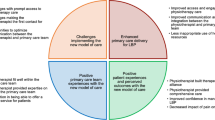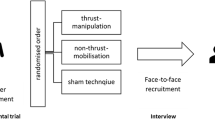Abstract
Purpose
For clinicians, treating the cause of non-pathological low back pain (LBP) is central. For patients, it is how LBP limits their activities of daily living. Little is known about clinicians’ understanding of disability and the patient’s perspective. We conducted a qualitative study to examine how clinicians involved in the care of patients with BP describe and define disability, its associated changes, and rehabilitation.
Methods
Two focus groups (FGs) were conducted with spine specialists including eleven confirmed orthopedic surgeons and neurosurgeons, ten advanced residents, and five other clinicians. Participants were questioned about their views on disability, what it means to them and to the patients. Responses were collected by two independent observers using Metaplan techniques. Large stickers were used to collect participants’ responses/ideas; the stickers were posted on billboards so the FGs could check them during the discussion. Metaplan was used to aggregate responses.
Results
Disability was viewed as a major source of physical limitations, difficulties in performing daily activities, associated with emotional distress, and raising legitimacy issues. Changes in roles engaged the social component. Considered from the patients’ perspective, negative emotions and social issues were emphasized, along with the patients’ resources. For rehabilitation, the participants emphasized patient-centered care, teamwork, and objectives for care.
Conclusion
The participants pointed to disability as an umbrella term for impairments, activity limitations, and participation restrictions. They underlined the necessity for clinicians to help patients define their level of optimal functioning when faced with BP, utilizing adaptation and teamwork within the therapeutic relationship.

Similar content being viewed by others
References
Global Burden of Disease, Injury Incidence, Prevalence Collaborators. Global, regional, and national incidence, prevalence, and years lived with disability for 310 diseases and injuries, 1990–2015: a systematic analysis for the Global Burden of Disease Study Lancet 2016: 388:1545–1602.
Hoy DG, Smith E, Cross M, Sanchez-Riera L, Blyth FM, Buchbinder R et al (2015) Reflecting on the global burden of musculoskeletal conditions: lessons learnt from the global burden of disease 2010 study and the next steps forward. Ann Rheum Dis 74:4–7
Hartvigsen J, Hancock MJ, Kongsted A, Louw Q, Ferreira ML, Genevay S, Hoy D et al (2018) What low back pain is and why we need to pay attention. Lancet 391(10137):2356–2367
World Health Organization (2001) The ICF: An overview. Switzerland, Geneva
Ogden J (2012) Health psychology: a textbook. Open University Press, Philadelphia
Cieza A, Sabariego C, Bickenbach J, Chatterji S (2018) Rethinking disability. BMC Med 16:14. https://doi.org/10.1186/s12916-017-1002-6
Linton SJ, Shaw WS (2011) Impact of psychological factors in the experience of pain. Phys Ther 91(5):700–711. https://doi.org/10.2522/ptj.20100330
Beaton DE, Clark JP (2009) Qualitative research: a review of methods with use of examples from the total knee replacement literature. J Bone Joint Surg Am 91(Suppl 3):107–112
Forman J, Creswell JW, Damschroder L, Kowalski CP, Krein SL (2008) Qualitative research methods: key features and insights gained from use in infection prevention research. Am J Infect Control 36:764–771. https://doi.org/10.1016/j.ajic.2008.03.010
Pope C, Mays N (1995) Reaching the parts other methods cannot reach: an introduction to qualitative methods in health and health services research. BMJ 311:42–45
Giacomini MK, Cook DJ (2000) Users' guides to the medical literature: XXIII. Qualitative research in health care B. What are the results and how do they help me care for my patients? Evidence-Based Medicine Working Group. JAMA 284:478–82
Kitzinger J (1995) Qualitative research. introducing focus groups. BMJ 311:299–302
Cyr J (2016) The pitfalls and promise of focus groups as a data collection method. Sociol Meth Res 45:231–259. https://doi.org/10.1177/0049/24115570065
Carey MA (2015) Focus group. In: Wright J (ed) international encyclopedia of the social and behavioral sciences, 2nd edn. Elsevier, Oxford, pp 274–79
Kitzinger J (1994) The methodology of focus groups: the importance of interaction between research participants. Sociol Health Illn 16:103–121
Tong A, Sainsbury P, Craig J (2007) Consolidated criteria for reporting qualitative research (COREQ): a 32-item checklist for interviews and focus groups. Int J Qual Health Care 19:349–357
Dicicco-Bloom B, Crabtree BF (2006) The qualitative research interview. Med Educ 40:314–321
Amirabdollahian F, op den Akker R, Bedaf S, Bormann R, Draper H, Evers V et al. Assistive technology design and development for acceptable robotics companions for ageing years Paladyn, Journal of Behavioral Robotics 2013; 4(2):94–112. DOI: 10.2478/pjbr-2013–0007
Schnelle W, Stoltz I. The Metaplan method: COMMUNICATION tool for planning learning groups. (Metaplan Series No. 7). Goethestrasse: Germany, 1987. Retrieved from https://www.cipast.org/download/CD%20CIPAST%20in%20Practice/cipast/en/design_2_5_1.htm.
Dunlap K, Anderson GB, Rademacher J, McMenamy N (2011) An interdisciplinary focus group study on students’ perceptions of preparedness for upper-division coursework in teaching and nursing. J Gen Educ 60:172–193. https://doi.org/10.1353/jge.2011.0013
Rademacher J, Schumaker J, Deshler D (1996) Development and validation of a classroom assignment routine for inclusive settings. Learn Disab Quart 19:163–178
Cowart M, Rademacher J (1998) In my opinion: what students say about professional development schools. Teach Change 6:21–6
MacNeela P, Doyle C, O'Gorman D, Ruane N, McGuire BE (2015) Experiences of chronic low back pain: a meta-ethnography of qualitative research. Health Psychol Rev 9:63–82
Froud R, Patterson S, Eldridge S, Seale C, Pincus T, Rajendran D et al (2014) A systematic review and meta-synthesis of the impact of low back pain on people's lives. BMC Musculoskelet Disord 15:50
World Health Organization (2011) World report on disability. World Health Organization, Geneva
World Health Organization (2015) WHO global disability action plan 2014–2021. Better health for all people with disability. WHO, Geneva
Gardner T, Refshauge K, Smith L, McAuley J, Hübscher M, Goodall S (2017) Physiotherapists' beliefs and attitudes influence clinical practice in chronic low back pain: a systematic review of quantitative and qualitative studies. J Physiother 63:132–143
Acknowledgements
The authors wish to acknowledge all the participants to two focus groups conducted during the EUROSPINE Course "How to make your research more relevant, feasible and publishable" who have contributed to data collection for their most valuable and important contribution, as well as Julie-Lyn Noël and Sandy Sutter for their logistic support.
Author information
Authors and Affiliations
Corresponding author
Ethics declarations
Conflict of interest
There are no conflicts to be declared.
Additional information
Publisher's Note
Springer Nature remains neutral with regard to jurisdictional claims in published maps and institutional affiliations.
Rights and permissions
About this article
Cite this article
Christine, C., Marco, C., Louis-Rachid, S. et al. Clinicians’ views about the experience of disability due to low back pain. Results from a focus group study. Eur Spine J 29, 1953–1958 (2020). https://doi.org/10.1007/s00586-020-06463-y
Received:
Accepted:
Published:
Issue Date:
DOI: https://doi.org/10.1007/s00586-020-06463-y




